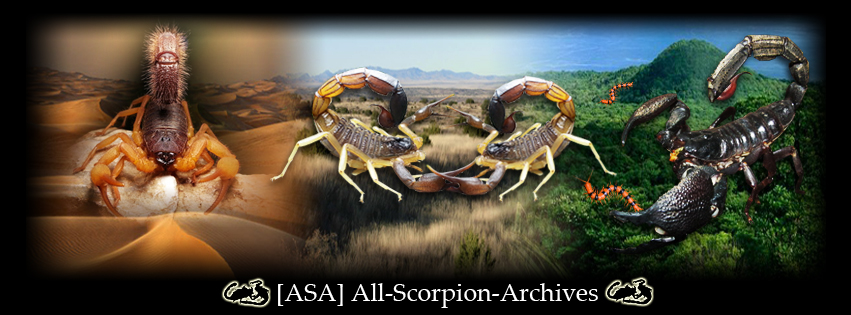Hottentotta gentili (Pallary, 1924)
Page 1 of 1
 Hottentotta gentili (Pallary, 1924)
Hottentotta gentili (Pallary, 1924)
General description:
These wonderful scorpions (ranging between 70–110 mm in length) are a beautiful, glossy black, with slightly reddish brown chelae and telson. Hottentotta gentili occur in Morocco and Algeria, and they are one of the most dangerous scorpion species there, killing several people each year (primarily children). Their highly territorial behaviour is one of the main reasons for this. Instead of running, they tend to stand their ground. Some of my specimens even approach and attack anything that comes within range, so care should be taken during maintenance, feeding and rehousing. They are very, VERY prone to sting. NEVER handle these!
Care:
I've been keeping mine on a substrate consisting of shredded coco fibres and sand (mostly sand, and about a quarter of coco peat). Their hides are pieces of rock and pieces of cork bark. The scorpions are usually out in the open, unless they are getting ready to molt.
I keep them at a temperature of about 34 degrees Celsius (95 degrees Fahrenheit) during the day, for 12 hours a day. During the night, I let it drop to room temperature (20 degrees Celsius/68 Fahrenheit, or a bit less during the winter). This following fact might seem quite controversial, but I keep the heating mat underneath the tank, to heat half of the substrate. Since these are a lithophilic (rock-loving) species that do not burrow, I guessed they would be used to high temperatures. I seem to be right, since my specimens usually molt without any problems. In fact, the only specimen I ever lost died because his enclosure was too wet when he started molting. I never made that mistake again. Now I lightly mist a quarter of the enclosure once a week, and they're doing fine.
I fed them twice a week when they were younger (instar 2). After they molted to instar 3, I started feeding them once a week, with an appropriately sized prey item.
In my experience, these are rather slow growers, taking about 2 years or more to mature.
When I gain more experience with these (i.e. successfully breeding them, etc.), I will expand this care sheet. For now, I hope this information was useful!

Young specimen, instar 3 (freshly moulted)

Juvenile, instar 4 (freshly moulted)
Sources:
www.hottentotta.com (for the general info)
Serket, the Arachnological Bulletin of the Middle East and North Africa, Volume 13, September 2012 (for the information about the venom potency)
My own experience
Pics were made by my father
These wonderful scorpions (ranging between 70–110 mm in length) are a beautiful, glossy black, with slightly reddish brown chelae and telson. Hottentotta gentili occur in Morocco and Algeria, and they are one of the most dangerous scorpion species there, killing several people each year (primarily children). Their highly territorial behaviour is one of the main reasons for this. Instead of running, they tend to stand their ground. Some of my specimens even approach and attack anything that comes within range, so care should be taken during maintenance, feeding and rehousing. They are very, VERY prone to sting. NEVER handle these!
Care:
I've been keeping mine on a substrate consisting of shredded coco fibres and sand (mostly sand, and about a quarter of coco peat). Their hides are pieces of rock and pieces of cork bark. The scorpions are usually out in the open, unless they are getting ready to molt.
I keep them at a temperature of about 34 degrees Celsius (95 degrees Fahrenheit) during the day, for 12 hours a day. During the night, I let it drop to room temperature (20 degrees Celsius/68 Fahrenheit, or a bit less during the winter). This following fact might seem quite controversial, but I keep the heating mat underneath the tank, to heat half of the substrate. Since these are a lithophilic (rock-loving) species that do not burrow, I guessed they would be used to high temperatures. I seem to be right, since my specimens usually molt without any problems. In fact, the only specimen I ever lost died because his enclosure was too wet when he started molting. I never made that mistake again. Now I lightly mist a quarter of the enclosure once a week, and they're doing fine.
I fed them twice a week when they were younger (instar 2). After they molted to instar 3, I started feeding them once a week, with an appropriately sized prey item.
In my experience, these are rather slow growers, taking about 2 years or more to mature.
When I gain more experience with these (i.e. successfully breeding them, etc.), I will expand this care sheet. For now, I hope this information was useful!

Young specimen, instar 3 (freshly moulted)

Juvenile, instar 4 (freshly moulted)
Sources:
www.hottentotta.com (for the general info)
Serket, the Arachnological Bulletin of the Middle East and North Africa, Volume 13, September 2012 (for the information about the venom potency)
My own experience
Pics were made by my father
EmielVrolijk- Spermatophore
- Posts : 5
Join date : 2014-06-08
Age : 33
Location : Near Emmen
 Similar topics
Similar topics» Female Hottentotta gentili
» Is it necessary to place water dish for hottentotta hottentotta sp.?
» [ASA] Hottentotta hottentotta caresheet
» Hottentotta hottentotta
» Hottentotta jayakari
» Is it necessary to place water dish for hottentotta hottentotta sp.?
» [ASA] Hottentotta hottentotta caresheet
» Hottentotta hottentotta
» Hottentotta jayakari
Page 1 of 1
Permissions in this forum:
You cannot reply to topics in this forum